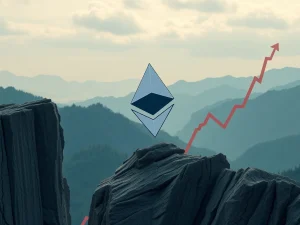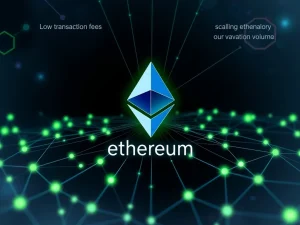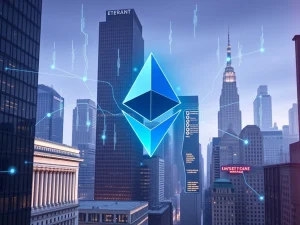Urgent Call: Vitalik Buterin Champions Higher Ethereum Gas Limit for Critical Network Boost

In a bold move that has reignited the ever-present debate around blockchain scalability, Ethereum’s co-founder, Vitalik Buterin, has once again stepped into the limelight, advocating for an even higher Ethereum gas limit. This isn’t just another technical tweak; it’s a proposition that could fundamentally alter the landscape of the Ethereum network, impacting everything from transaction costs to censorship resistance. For those deeply invested in the crypto world, especially in Ethereum and its burgeoning ecosystem, this development is nothing short of critical. Let’s dive into why Vitalik believes this is a necessary step and what it could mean for the future of ETH.
Why is Vitalik Buterin Pushing for a Higher Ethereum Gas Limit?
Vitalik Buterin’s recent statements aren’t just casual suggestions; they are grounded in a strategic vision for Ethereum’s long-term health and efficiency. His arguments for increasing the ETH gas limit are multifaceted and address some of the most pressing challenges and opportunities facing the network today. Let’s break down the key reasons behind his advocacy:
-
Enhanced Censorship Resistance: In an increasingly interconnected and sometimes politically charged world, censorship resistance is paramount for decentralized platforms. A higher gas limit can empower the network to handle more transactions, making it harder for any single entity to censor or halt specific activities. This is crucial for maintaining Ethereum’s core tenet of being a permissionless and open platform for all.
-
Reduced Costs for Layer 2 (L2) Asset Routing: Layer 2 scaling solutions are vital for Ethereum’s scalability, offering faster and cheaper transactions. However, moving assets between these L2s and the main Ethereum chain (Layer 1) still incurs costs. A higher gas limit could significantly reduce these costs, making the entire L2 ecosystem more fluid and efficient. This is particularly important as L2 solutions become more integrated into everyday crypto use.
-
Disaster Safety Net: Imagine a scenario where a major event causes a surge in on-chain activity. A higher gas limit acts as a safety valve, allowing the network to absorb unexpected spikes in demand without grinding to a halt. This resilience is not just about convenience; it’s about ensuring the network remains operational and reliable even under extreme circumstances. Think of it as an emergency reserve capacity for the blockchain.
Understanding the Ethereum Gas Limit: A Quick Primer
For those newer to the crypto space, the concept of the Ethereum gas limit might seem a bit technical. In simple terms, the gas limit is the maximum amount of computational effort (measured in ‘gas’) that each block on the Ethereum blockchain can expend. Every transaction on Ethereum requires a certain amount of gas to be executed. Miners, who validate transactions and add them to the blockchain, prioritize transactions with higher gas fees. Think of gas as the fuel that powers the Ethereum engine. The gas limit, therefore, dictates how much ‘fuel’ each block can consume.
Increasing the gas limit means each block can process more transactions. This can lead to:
-
Higher Transaction Throughput: More transactions can be processed per second, potentially reducing congestion during peak times.
-
Potentially Lower Average Gas Fees: While not always guaranteed, a higher capacity can alleviate pressure on gas prices, especially during periods of high demand. However, it’s important to note that gas fees are also influenced by transaction demand.
However, it’s not as simple as just cranking up the gas limit. There are crucial considerations and potential drawbacks to keep in mind.
The Double-Edged Sword: Potential Challenges of Raising the ETH Gas Limit
While the benefits of a higher Ethereum gas limit as advocated by Vitalik are compelling, it’s crucial to acknowledge the potential challenges and trade-offs. This isn’t a decision to be taken lightly, and the Ethereum community is actively debating these very points.
Increased Resource Demands for Nodes: A larger gas limit means nodes need to process more data and computation for each block. This can lead to:
| Challenge | Description | Potential Impact |
|---|---|---|
| Higher Hardware Requirements | Nodes may need more powerful CPUs, faster storage (like SSDs), and increased bandwidth to handle the increased workload. | Could potentially increase the cost of running a node, potentially centralizing node operation among those with more resources. |
| Longer Block Propagation Times | Larger blocks take longer to propagate across the network. | Could slightly increase block times and potentially impact network latency, although Ethereum’s fast block times mitigate this to some extent. |
| Increased Storage Requirements | A higher gas limit over time means more data is added to the blockchain, increasing storage demands for full nodes. | Can contribute to blockchain bloat, although Ethereum’s state management and pruning efforts are designed to address this over the long term. |
Security Considerations: While not directly a security risk in itself, increasing the gas limit needs to be carefully calibrated to ensure it doesn’t introduce unforeseen vulnerabilities or strain the network in ways that could be exploited. Thorough testing and analysis are essential.
Ethereum Gas Fees: How Does the Gas Limit Impact Costs?
The question on everyone’s mind, especially users of Ethereum, is: how will this impact ETH gas fees? It’s not a straightforward relationship. Increasing the gas limit can lead to lower average gas fees, particularly during times of high network congestion. This is because the network can process more transactions in each block, effectively increasing supply. However, if demand for block space continues to outpace the increased capacity, gas fees might not decrease significantly, or could even increase if network usage surges even further.
Think of it like adding more lanes to a highway. If traffic is consistently heavy, adding lanes can ease congestion and potentially speed up travel times (and reduce ‘fees’ in this analogy). But if even more cars start using the highway, the congestion might return, even with the added lanes. The actual impact on ETH gas fees will depend on the interplay between network capacity and user demand.
Vitalik’s Vision and Blockchain Scalability: The Bigger Picture
Vitalik’s advocacy for a higher gas limit is part of a broader push towards blockchain scalability for Ethereum. He and the Ethereum Foundation are working on multiple fronts to enhance the network’s capacity and efficiency, including:
-
Layer 2 Solutions: Rollups (like Optimistic and ZK-rollups) are off-chain scaling solutions that bundle multiple transactions and submit them to the main chain as a single transaction, significantly reducing gas costs and increasing throughput. A higher gas limit can complement L2s by making interactions between L1 and L2 more efficient.
-
Sharding: This is a major upgrade in Ethereum’s roadmap that aims to split the blockchain into multiple shards, each capable of processing transactions independently. Sharding is expected to dramatically increase Ethereum’s transaction processing capacity.
-
EIP-4844 (Proto-Danksharding): A precursor to full sharding, EIP-4844 introduces ‘blobs’ of data that are cheaper to store on-chain, specifically designed to benefit Layer 2 rollups and further reduce their costs.
Increasing the Ethereum gas limit is seen by some as a more immediate, though potentially less impactful in the long run compared to sharding, way to address current scalability challenges. It’s a lever that can be adjusted more quickly than implementing major architectural changes like sharding.
Layer 2 Scaling: The Synergistic Effect of a Higher Gas Limit
The interplay between a higher gas limit and layer 2 scaling solutions is a crucial aspect of Vitalik’s argument. As mentioned earlier, reducing costs for routing assets between L2s is a key benefit. Here’s how a higher gas limit can synergize with L2s:
-
Lower Bridging Costs: Moving assets between Ethereum mainnet and L2s, or between different L2s, often involves transactions on the main chain. A higher gas limit can reduce the gas costs associated with these bridging operations, making the entire L2 ecosystem more cost-effective.
-
Improved L2 Onboarding: When new users onboard to L2s, they often need to interact with the main chain initially to deposit funds. Lower gas fees on L1 can make this onboarding process smoother and cheaper, encouraging wider adoption of L2 solutions.
-
Enhanced Data Availability for L2s: Some L2 solutions rely on posting data on the main chain for data availability. A higher gas limit could potentially allow L2s to post more data more affordably, enhancing their security and functionality.
In essence, a higher gas limit can act as a catalyst, making layer 2 scaling solutions even more attractive and efficient, accelerating the transition towards a more scalable Ethereum ecosystem.
The Road Ahead: What’s Next for the Ethereum Gas Limit Debate?
Vitalik’s proposal is likely to spark further discussions and debates within the Ethereum community. Any potential increase in the Ethereum gas limit would need to be carefully considered, tested, and implemented through the Ethereum Improvement Proposal (EIP) process. It’s not a decision that will be made overnight, and the community will weigh the potential benefits against the risks and challenges.
Key questions being considered likely include:
-
What is the optimal increase in the gas limit that balances benefits and risks?
-
What are the long-term implications for node operators and network decentralization?
-
How will this change impact ETH gas fees in various network conditions?
-
How does this fit into the broader Ethereum roadmap and the development of sharding and other scaling solutions?
The conversation around the Ethereum gas limit is a vital part of the ongoing evolution of the network. It reflects the constant effort to balance scalability, security, and decentralization – the core trilemma of blockchain technology.
In Conclusion: A Critical Juncture for Ethereum’s Scalability
Vitalik Buterin’s renewed push for a higher Ethereum gas limit underscores the urgent need to address scalability challenges and ensure Ethereum remains competitive and accessible. While it’s not a silver bullet solution, it represents a potentially impactful step that could bring tangible benefits in terms of censorship resistance, L2 efficiency, and network resilience. However, it’s also a move that requires careful consideration of the potential trade-offs and long-term implications.
As the Ethereum community deliberates on this crucial issue, one thing is clear: the pursuit of blockchain scalability is an ongoing journey, and the debate around the gas limit is just one chapter in the larger story of Ethereum’s evolution. Staying informed and engaged in these discussions is essential for anyone invested in the future of crypto and decentralized technologies.









